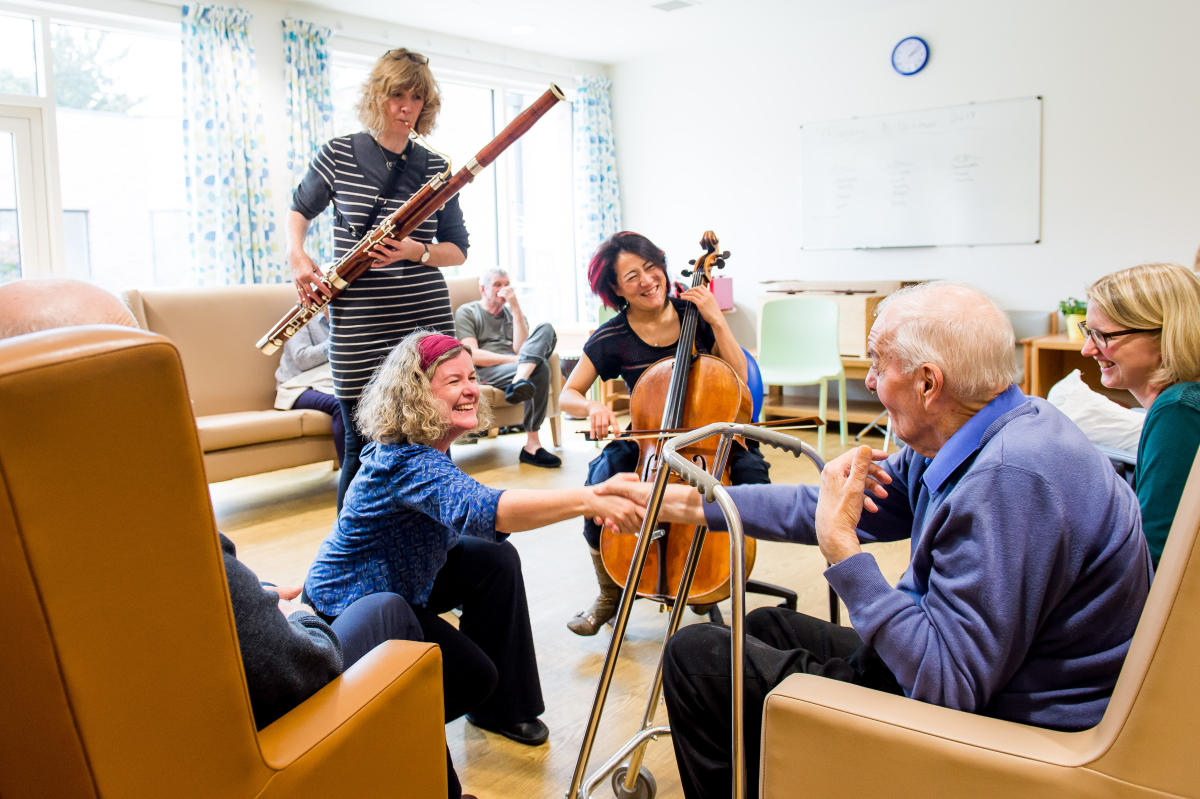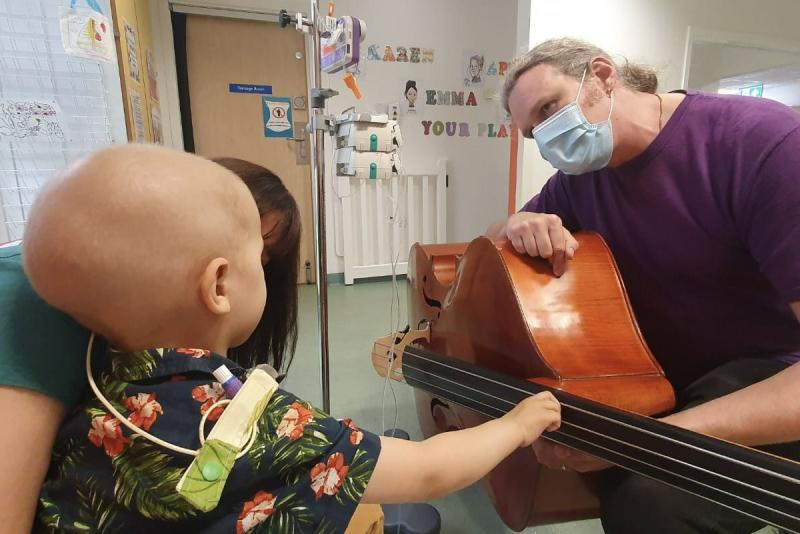
ReConnect is a programme of interactive music workshops for people living with dementia
Photo: Fraser Band
Orchestras in healthcare
A recent report reinforces the UK-wide picture of the great work orchestras do in delivering societal good. As Sarah Derbyshire writes, there are encouraging signs of progress over the past three years.
Despite that progress, this second Orchestras in Healthcare report* also shows there are significant barriers to scaling up activities by orchestra musicians in formal and informal care settings, and orchestras themselves are frustrated from meeting their own ambitions for the work. Our analysis of the data tells us that a radical rethink is required to address the situation.
Importantly, the second report represents cross-sector authorship, thanks to my fellow contributors Natalie Ellis (Cambridge University Hospitals NHS Trust), Fiona Harvey (Association of British Orchestras), Matthew Swann (independent consultant) and Laura Waters (University Hospitals of Derby and Burton NHS Trust). Collaboration between the orchestral and health sectors is an essential building block for sustainable growth, as restated by James Sanderson (NHS England) and Darren Henley (Arts Council England) in their introductions to the report.
But collaboration will continue to be thwarted if we don’t act to remove systemic barriers to meaningful development. Drilling down into the data begins to reveal the fault lines.
Positive trends
The number of orchestras responding and delivering work in 2023 has risen slightly but, more significantly, there’s been a huge uplift in average funding per orchestra (£103,128 – a 68% increase on 2020) and work in health and wellbeing settings is an increasingly significant source of funds in orchestras’ overall income.
Many orchestras are now raising up to half – with a significant number raising the majority – of their total income for engagement/learning and participation income (l&p) through healthcare activity. And 24% of the total raised is from new, health-related sources.
But these positive trends are not experienced equally across orchestras. With one or two notable exceptions, chamber orchestras are significantly outperforming symphony orchestras in terms of income raised for this activity. They raise more, in both their overall levels of organisational income and as a proportion of their total l&p programme income. Half of all chamber orchestras who contributed to this survey stated that over 50% of their l&p income was for healthcare activity.
The reasons lie chiefly in the difference between chamber and symphony orchestra business models. Chamber orchestras typically employ musicians on a freelance basis and are less constrained by concert scheduling. Their more nimble and reactive business models allow them to create flexible relationships with healthcare partners and explore new areas of work.
 Britten Sinfonia musician working with CUH (Cambridge University Hospitals) Sounds. Photo Media Studio
Britten Sinfonia musician working with CUH (Cambridge University Hospitals) Sounds. Photo Media Studio
Benefits of including healthcare within the orchestra
By contrast, symphony orchestras’ musicians are typically salaried and have far busier concert diaries. Of those responding to the survey, 40% cited scheduling issues as challenges to undertaking this work.
Other symphony orchestras cited the time needed for training and recruiting musicians for this activity as a challenge, factors which no chamber orchestra cited. And indeed, the report indicates that investment in support, training and wellbeing of musicians pays off in terms of recruitment and retention, presenting a strong case for the benefits of incorporating high quality healthcare activity at the heart of an orchestra’s operation.
Compared to 2020, there is a significant change in orchestras’ recognition that this activity is important for musicians not just in terms of economic and creative practice benefits, but in providing meaningful work that contributes to their wellbeing.
Another welcome, positive trend is the shift towards a realisation that everyone who encounters an orchestra is part of its ‘audience’, whether in formal performance spaces or not. There can be no more diverse or representative audience than those accessing services for their physical and emotional wellbeing.
A radical rethink of return on investment
How can orchestras operating within rigid scheduling and business models overcome these constraints and respond to the growing opportunities available for partnership within the creative health sector?
The answer lies in a radical rethink at the highest level, within cultural organisations and their funders, of what constitutes a return on investment. Overall, the report is persuasive in underlining the business case for orchestras in developing their workforce and exploring new partnerships. The potential for this work to demonstrate, every day and in every community, that orchestra musicians are part of the fabric of society, bringing joy, comfort and healing, is unparalleled.
It cannot be demonstrated by the bottom line, only by the narrative of those who experience it (as creatives and participants) and demonstration of the long-term benefits that accrue. For the orchestras, that amounts to a far wider recognition of their creative workforce and impact beyond the concert platform.
For funders and partners, it requires rethinking evaluation systems to encompass methods that articulate social impact, wrapping in qualitative methods but crucially, assessing the return in long-term savings achieved through healthier communities.
Sarah Derbyshire MBE is Chief Executive of Orchestras Live.
![]() orchestraslive.org.uk
orchestraslive.org.uk
![]() @OrchestrasLive | @sarahderbyshire
@OrchestrasLive | @sarahderbyshire
![]() /orchestras-live | /sarahderbyshire
/orchestras-live | /sarahderbyshire
*Orchestras in Healthcare was published and launched at the Association of British Orchestras annual conference in January 2024 and can be downloaded here.
Join the Discussion
You must be logged in to post a comment.